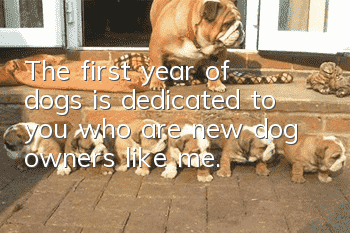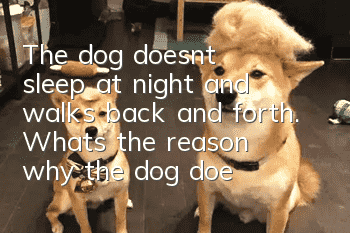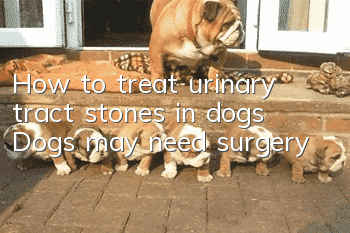(The first year of dogs) is dedicated to you who are new dog owners like me.

A dog's physical and mental state is mostly determined around one year old, so in the first year of a dog's life, owners need to spend more time and effort taking care of it. Maybe there are no major problems, but there are many minor ones. Before it matures, the owner should not be too sure of its IQ, nor should it be discouraged too early.
1. From birth to one week old
When a puppy is born, its eyes and ears are tightly closed, and it cannot stand or walk. The sucking reflex is very strong, and a large amount of transitional antibodies can be obtained from the colostrum, which is enough to protect it until it is two months old. Proper insulation is required during this period, especially in the cold winter, because the puppy cannot maintain normal body temperature on its own. For a small number of dogs that need tail docking, it can be done about four days after birth, because the pain is very weak during this period and no anesthesia is needed.
2. One week to three weeks old
In about ten days to two weeks, the puppy's eyes and ears begin to open, its sense of smell slowly begins to function, and it gradually learns to stand and walk, and stumbles to find milk. The new world is very new to them, so try to avoid excessive stimulation of sound and light. The dog's ancient wisdom has taught it to urinate and urinate in places other than the nest. After two weeks, the baby teeth begin to grow in.
3. One to two months old
This is the puppy’s socialization period, when it begins to get to know its family and owner. When one to two months old, the puppy's eating habits begin to change, and it can eat semi-solid food, such as meat sauce, soaked dry food, and drink water. The deciduous teeth gradually grow, and when sucking milk, they will bite and hurt the mother and she will gradually wean from the milk. Its curiosity kicks in and it loves to bite anything it can find.
Dogs begin to need health examinations, deworming, and vaccinations. At the same time, you can start letting it live in its own nest and sleep in its own bed. At this time, you might as well tie a bell around the dog's neck to prevent it from being stepped on accidentally by adults or children when it walks around.
4. Two to four months old
Deworming and vaccination are all things that the owner should pay attention to during this period; at the same time, basic life training should be started to make it accustomed to combing and brushing. After the basic immunization injections are completed, heartworm preventives should be taken.
5. Four to five months old
As the deciduous teeth begin to be replaced and the permanent teeth begin to grow in, the dog's mouth will be very itchy and he will try hard to bite everything he can. At this time, you might as well give it dog bones and toys that cannot be chewed. Never let it bite slippers, leather shoes, cloth shoes, wood, cloth, or bones, beef bones, chicken bones and other indigestible and difficult-to-digest things, which may easily cause indigestion.Tract obstruction, loss of appetite, and even vomiting.
The nipple hair begins to fall out, starting from the head and then the back. Finally, the downy fine hairs visible all over the body are replaced by new ones that are brighter and thicker. At this time, help brush and comb its fur. Avoid getting hair balls.
6. Six to seven months old
You can start giving your dog basic obedience training, two or three times a day, for five to ten minutes each time.
7. Eight to nine months old
Small and medium-sized dogs are close to maturity and have completed their teeth and hair changes. Male and female dogs can start to undergo birth control surgery. Female dogs can undergo surgery about two weeks after the first heat ends.
8. Ten to twelve months old
The dog is almost fully grown, its size has stabilized, its weight gain has slowed, and its personality has stabilized. Large dogs are not fully grown until they are fifteen to eighteen months old.
9. One year old
One year old is equivalent to eighteen years old in human beings. From then on, add four for every one year old a dog grows, which is equivalent to human physiological age. For example, a five-year-old dog is equivalent to us being about thirty-four years old.
Dogs after one year old have much fewer physical problems. If there are still some problems in your behavior, you must correct them as soon as possible. In this way, humans and dogs will get along very happily in the next ten years, becoming more and more understanding and caring.
- What should I do if my dog has no milk? The owner should check quickly and don’t let the puppies starve to death.
- Dog’s anal gland odor, please note that this is a sign of your dog’s health!
- How to make your dog like to eat dog food Four ways to make your dog fall in love with dog food
- How to protect your dog’s food? Teach you tips on training your dog
- Why do dogs defecate everywhere? How can dogs stop defecating everywhere?
- What should I do if my dog has lupus? Immune system diseases should not be underestimated
- If your dog's hair is cut and the skin is cut, the flesh is exposed. If the dog's hair is accidentally cut and the skin is cut, it must be disinfected immediately.
- Do dogs need deworming in summer? What should you pay attention to when raising dogs in summer?
- What to do if your dog has indigestion? Dog indigestion is no small matter!
- What should you pay attention to when vaccinating your dog? What should you pay attention to when vaccinating your dog?



